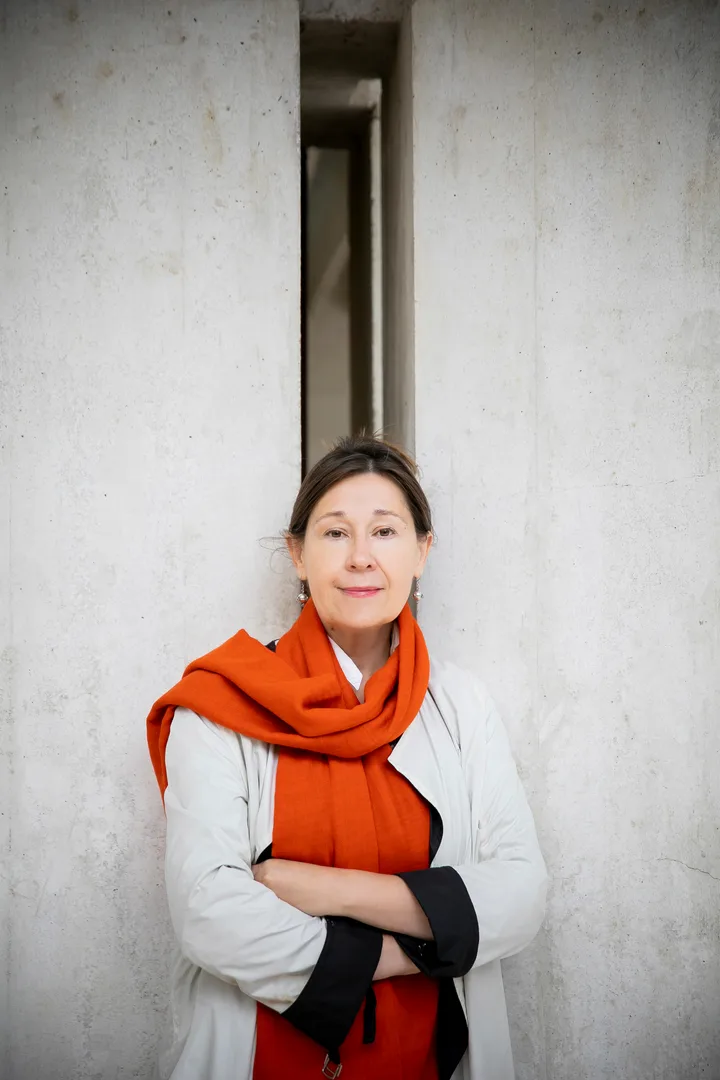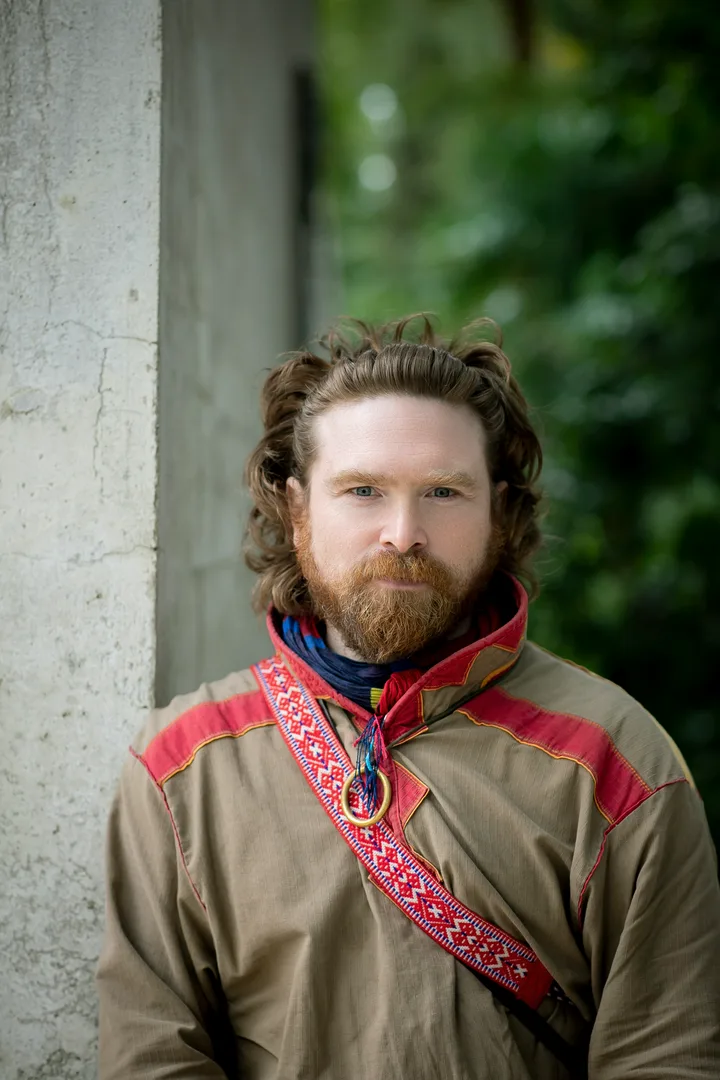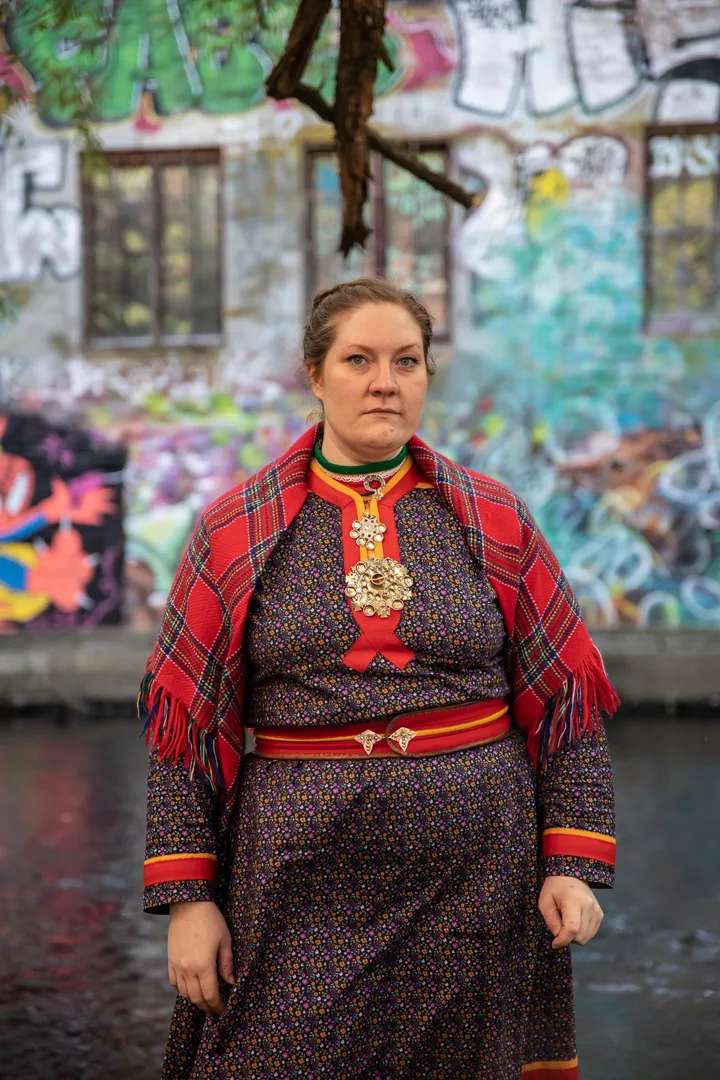
Curatorial Group
The exhibition is curated by a group consisting of Sámi scholar Liisa-Rávná Finbog, OCA’s Director Katya García-Antón and Sámi land guardian Beaska Niillas; curatorial assistants: Liv Brissach ( February 2020 - March 2022), Raisa Porsanger (February 2020 - December 2021) and Martina Petrelli (February 2022 - May 2022).
Katya García-Antón

Commissioner and co-curator of 'The Sámi Pavilion' Katya García-Antón. Photo: Marta Buso / OCA
Katya García-Antón is director and chief curator of the Office for Contemporary Art Norway (OCA), where she has held the post since 2014. A British and Spanish national, she graduated with a BA in biology from Bristol University, UK, specializing in primatology and ecology. She conducted field work in the Amazon forests in Brazil and in the Gola Forests in Sierra Leone, before transferring into the arts with a master’s degree in 19th- and 20th-century art history from The Courtauld Institute of Art, London. She worked as a curator at The Courtauld Institute of Art, Museo Nacional Reina Sofía Madrid, ICA London, IKON Birmingham, and was director of the Centre d’Art Contemporain Genève. She curated the Spanish Pavilions in the São Paulo Biennial 2004 and in the 54th International Art Exhibition – La Biennale di Venezia in 2011, the Nordic Pavilion in the 56th International Art Exhibition – La Biennale di Venezia in 2015 and was co-curator of the Qalandiya International Biennial 2022, in Jerusalem and Ramallah. García- Antón is member of the jury for the Artes Mundi International Exhibition and Award (AM10) in 2022 with Gaby Ngcobo, Wanda Nanibush and Zoe Butt.
She has curated over 100 exhibitions of art, design and architecture; most recently she was chief curator for OCA’s ‘Actions of Art and Solidarity’ (2021) presented in Kunstnernes Hus Oslo. Her extensive publications include, most recently, being editor/co-editor (contributing with essays) of OCA’s trilogy on new Indigenous writing: Sovereign Words. Indigenous Art, Curation and Criticism (2018), Mázejoavku. Indigenous Collectivity and Art (2020) and Let the River Flow. An Indigenous Uprising and its Legacy in Art, Ecology and Politics (2020), as well as the upcoming Art and Solidarity Reader. Radical Actions, Politics and Friendships (2022). In 2021 she presented keynote lectures on decolonial and Indigenising institutional practices in The Art Institute Basel’s Master Symposium ‘Seeing into the Heart of Things. Earth and Equality within Indigenous an Ancestral Knowledges’ and with Alserkal Foundation in Dubai World Expo 2022.
In 2015 García-Antón launched a long-term focus on the North (both in terms of climate change and Sámi perspectives and how they connect) called ‘Thinking from the Edge of the World. Perspectives from the North’. She was instrumental in the creation of the Artica Svalbard Foundation, in connecting scientific and artistic practices there; OCA is a key partner in Artica’s residency and curatorial activities.
At OCA, García-Antón has generated significant Indigenising practices and programmes, in particular related to Sámi art and thought, as well as facilitated greater connectivity between Sámi voices and Indigenous thinkers across the world in ground-breaking projects such as documenta14, the Sydney Biennial 2020, the 13th Gwanju Biennial 2021, amongst others. OCA is lead commissioner of the project that transforms the Nordic Pavilion into ‘The Sámi Pavilion’ at the 59th International Art Exhibition of La Biennale di Venezia, 2022. García-Antón is part of the curatorial group for ‘The Sámi Pavilion’.
In August 2022 she starts as director of the Northern Norway Art Museum (NNKM) whose headquarters are based in Tromsø, with a branch in Longyearbyen in the Svalbard Archipelago, and an upcoming branch in Bodø, near the Lofoten Archipelago.
Beaska Niillas

Co-curator of 'The Sámi Pavilion' Beaska Niillas. Photo: Marta Buso / OCA
Beaska Niillas from Deatnu in the Norwegian part of Sápmi, is among other things a father of two, Sámi duojár (Sámi storyteller and knowledge-holder), hunter, gatherer, land guardian and politician. Nature has been at the centre of his life since childhood. Growing up, the land was his playing field and his friend. He has done a lot of different things in his life, but the only formal education he has is a certificate of apprenticeship in duodji (Sámi practices of aesthetics and storytelling). For some time, he also worked as an actor in both Beaivváš Sámi National Theatre and Giron Sámi Theatre. After that he was a teacher and then worked as a fisherman. Nillas was recently re-elected to the Sámi Parliament on the Norwegian side of Sápmi and is also elected as board member of the Sámi Parlamentarian Council. Beaska, together with ‘The Sámi Pavilion’ co-curator Dr. Liisa-Rávná Finbogis is also a founding member of Hásstuheaddji collective, a Sámi led think-tank that gather thinkers, performers and artists to dialogue and reflect.
For the last ten years he has been active in Sámi politics and also defended Indigenous land and waters in Sápmi and beyond. Niillas plays a central role in three major projects exploring Sámi sovereignty: ‘Ellos Deatnu!’ (Long live Deatnu!), a group declaration of a moratorium around Čearretsuolu, an island on the Deatnu River in Sápmi, to oppose a new government-led fishing agreement harmful to the river and to Sámi life because it removes many local Sámi fishing rights and transfers them to outside recreational fishing; ‘SuperSápmi’, an Indigenous podcast founded and recorded with Sámi fisherman and land guardian Áslat Holmberg, bringing Sámi, Indigenous and allied voices together to discuss Indigenous knowledges as well as the impact of colonialism on Indigenous and specifically on Sámi everyday life; and ‘Siidaskuvla’, a collaborative project by Sámi scholars, artists and land guardians who seek to reconstruct the knowledge of the siida (the Sámi community structure), and discuss how it could operate as a Sámi governance structure today.
Dr. Liisa-Rávná Finbog

Co-curator of 'The Sámi Pavilion' Liisa-Rávná Finbog. Photo: Eirin Torgersen / OCA
Dr. Liisa-Rávná Finbog is a Sámi scholar and duojár (Sámi storyteller and knowledge-holder) from Oslo, Vaapste, and Skánit in the Norwegian part of Sápmi. As a long-term practitioner of duodji (Sámi practices of aesthetics and storytelling), her PhD in museology combined her practice with an Indigenous research focus that looked into duodji as a Sámi system of knowledge; the devastating effect of the colonial epistemicide on the practice of duodji; and how Sámi communities today work to re-remember practices within duodji and in the process negotiate Sámi identities; and lastly, how museums with their vast collections of Sámi heritage objects play into these processes.
Extending from this research, she curated the seminar ‘Dåajmijes Vuekie – the material expressions of Sámi aesthetics’, which was convened during the Sámi Art Festival of 2019. The same year she was also the curator of a seminar convened jointly by Office for Contemporary Art Norway (OCA) and Norwegian Crafts (NC) relating to the United Nations International Year of Indigenous Languages, entitled ‘Båassjoeraejken Tjïrr – Workshops and conversations on Indigenous languages, aesthetic practices and landscapes’.
She is currently based in Tampere, on the Finnish side of Sápmi, where she is doing post-doctoral research in connection with ‘Mediated Arctic Geographies’, a project that aims to look at how Arctic geospheres are aesthetically shaped and mediated to become vehicles of environmental, geopolitical and social concerns at Tampere University. Her specific focus is on the relation between Indigenous aesthetics in the Arctic and land. Finbog, together with ‘The Sámi Pavilion’ co-curator Beaska Niillas is also a founding member of Hásstuheaddji collective, a Sámi led think-tank that gather thinkers, performers and artists to dialogue and reflect.
Finbog is a collaborator on the research project ‘The Space Between Us’ that strengthens intellectual relationships among nations with shared colonial histories in Canada, the Circumpolar and Pacific regions, connecting to digital and new media technology in the future. She is also a session leader in the upcoming Momus Emerging Critics Residency to help guide emerging critical writers develop texts that are informed by the breadth of global Indigenous art criticism, cultural protocols and citational practices.
Her written works include contributions to collective works such as ‘Research Journeys In/To Multiple Ways of Knowing’ (2019), articles in Nordic Museology (2015) and in the digital platform ‘Action Stories’ (2021), as well as several upcoming works, including her first book, It Speaks to You – Making kin through people, stories, and duodji in Sámi Museums (2022).